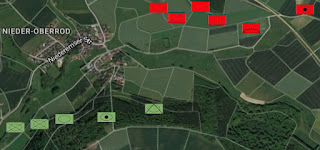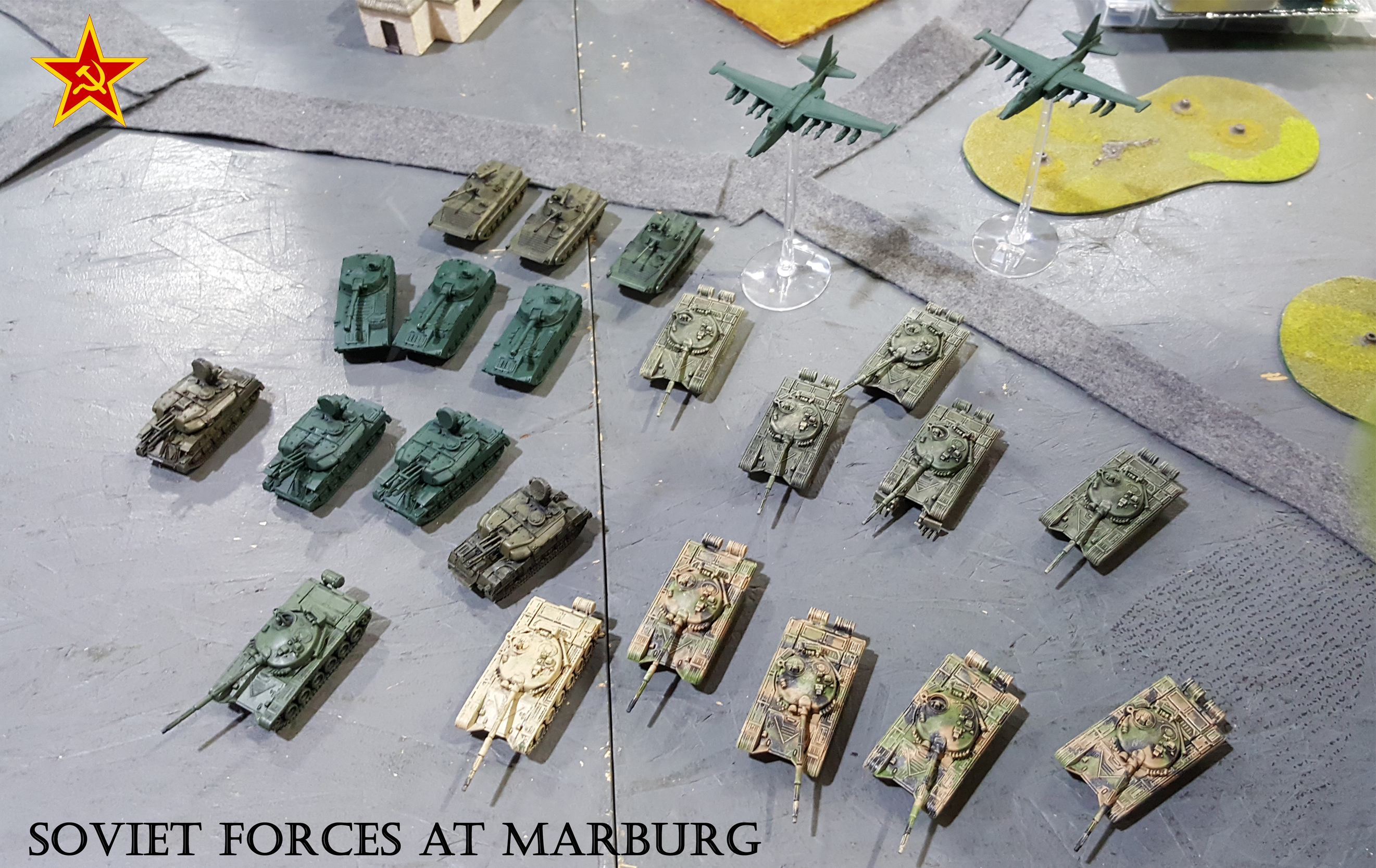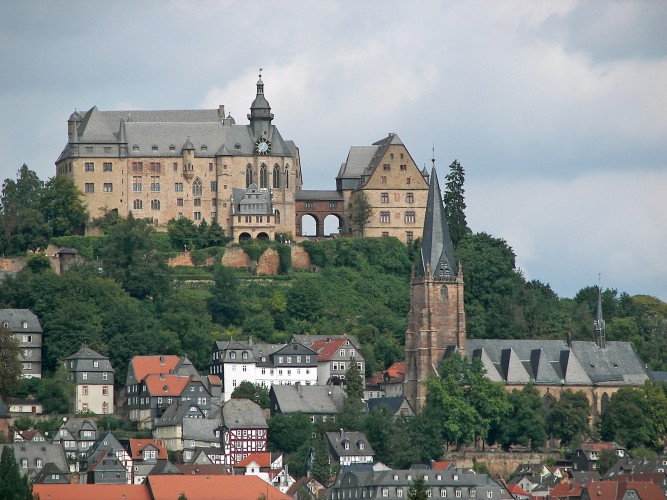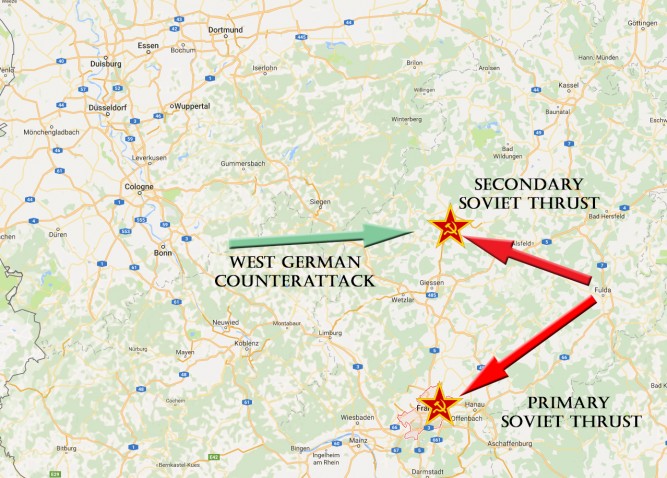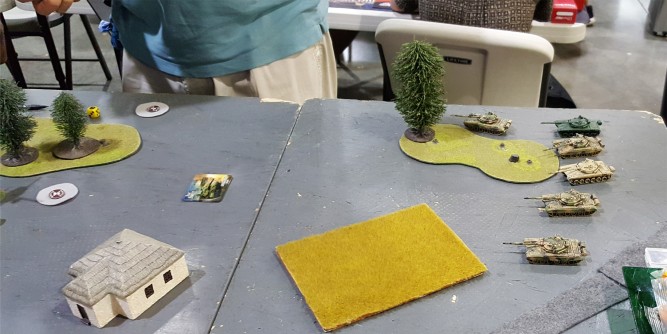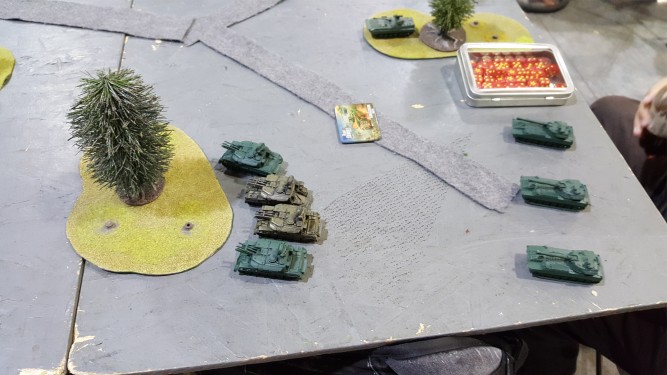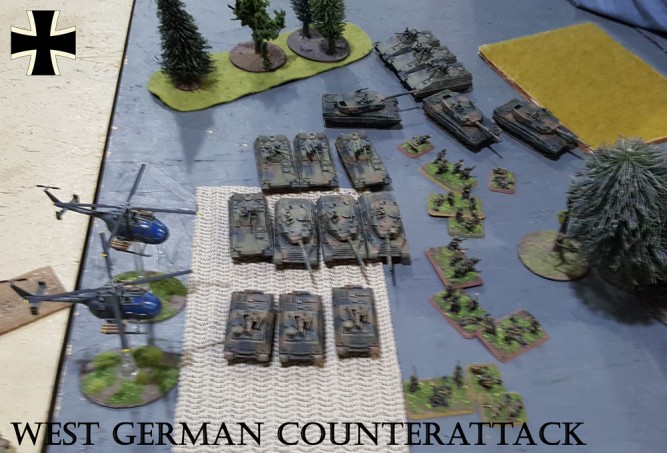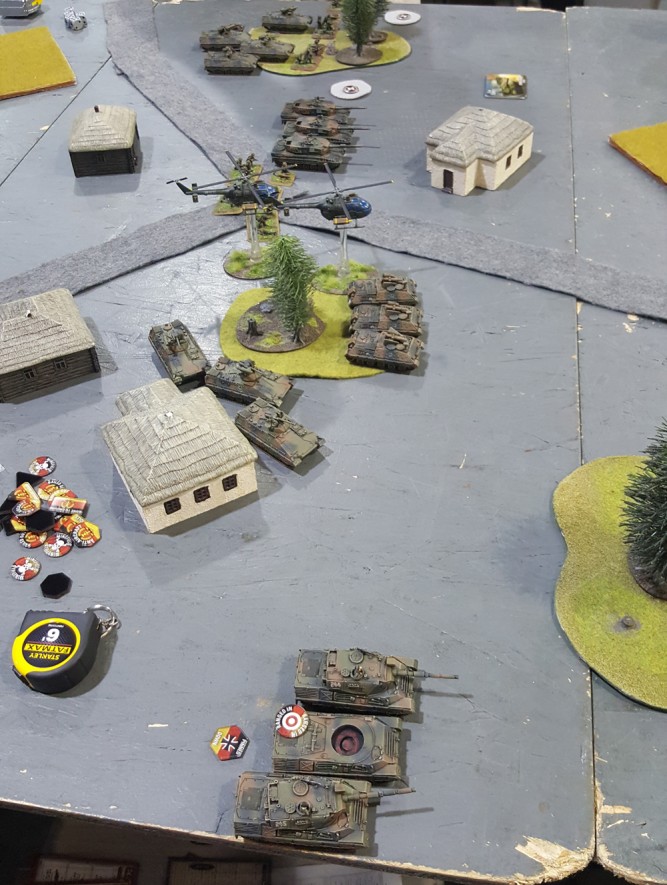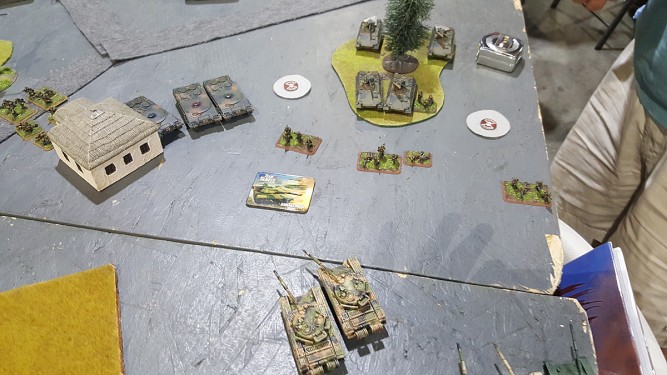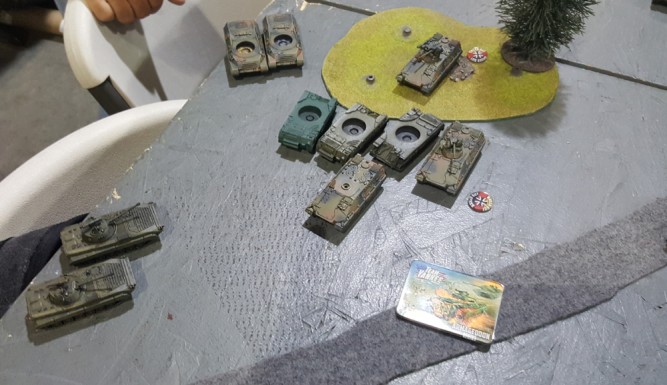Preamble
Guardian Games was hosting a Fighting First launch party today, and had three tables set up for people to come out and try the new American lists. Afterward, we'd set up for another Team Yankee game since I didn't get to try the Amsterdam mission on Thursday. Unfortunately we didn't get a chance to reset the tables with European terrain, so imagine if you will the Netherlands via Algeria... it could of course be the legal recreational pharmaceuticals merely making it LOOK like the desert.
I'd promised Ryan a return match since the last game went so poorly, and while this one wasn't a mirror image of the other game, it came close in a lot of ways. I ended up being far too aggressive with my armor - forgot the range on my Shilkas - and in short made a lot of rookie mistakes. Ryan, being a capable student of military history drew upon his Bonaparte - "Never interrupt your enemy when he is making a mistake." The game ended up being a 4-3 victory for the West Germans, but I picked up some slop points near the end once the game was already pretty much decided.
So in the spirit of accountability... our report follows!
Summary of the Court Martial Proceedings of Major Ivan Yakovlev
Accused is asked, "You are charged with gross dereliction of duty and cowardice in the face of the enemy, how do you plead?"
Accused pleads "Not Guilty"
Accused is asked to describe the planned attack in detail...
My armored battalion had broken through north of Amsterdam, but British, West German, and Dutch resistance was increasing and threatening to push us back out of The Netherlands. My group, on limited rest, was ordered to attack south toward Grijpskerk and Bedun north and north west of Groningen. We had set up temporary command posts at Kloosterburen and Waffrum, and it appears that NATO forces were targeting our command centers as we were targeting theirs...
Accused pleads "Not Guilty"
Accused is asked to describe the planned attack in detail...
My armored battalion had broken through north of Amsterdam, but British, West German, and Dutch resistance was increasing and threatening to push us back out of The Netherlands. My group, on limited rest, was ordered to attack south toward Grijpskerk and Bedun north and north west of Groningen. We had set up temporary command posts at Kloosterburen and Waffrum, and it appears that NATO forces were targeting our command centers as we were targeting theirs...
 |
| Soviets attempting a deep penetration attack |
Accused is asked, "What forces did you have available to you?"
Accused indicates that his total forces were three short companies of T-64 tanks, one Shilka battery, and a reconnaissance platoon of four BMP-2. His T-64 tanks were not armed with missile guidance systems, only guns. However the BMP-2 were scouting to the east and were not available immediately, and two of the three companies of T-64s were being re-armed and re-fueled when the attack order came.
Accused is asked, "Why were your forces in such a poor state of readiness? I'm told your Shilka battery failed to detect and engage enemy air power until they had already decimated your first company!"
Accused indicates that his armor had been fighting a running battle for several days and while the logistics company was working as quickly as possible, only one of the three tank companies had been readied for immediate deployment. He offers no excuse for the failure of the Shilka battery to immediately engage when they heard the rotors of the enemy helicopters.
Accused indicates that his total forces were three short companies of T-64 tanks, one Shilka battery, and a reconnaissance platoon of four BMP-2. His T-64 tanks were not armed with missile guidance systems, only guns. However the BMP-2 were scouting to the east and were not available immediately, and two of the three companies of T-64s were being re-armed and re-fueled when the attack order came.
Accused is asked, "Why were your forces in such a poor state of readiness? I'm told your Shilka battery failed to detect and engage enemy air power until they had already decimated your first company!"
Accused indicates that his armor had been fighting a running battle for several days and while the logistics company was working as quickly as possible, only one of the three tank companies had been readied for immediate deployment. He offers no excuse for the failure of the Shilka battery to immediately engage when they heard the rotors of the enemy helicopters.
Accused is asked to describe available enemy forces.
Accused indicates he was facing a mechanized infantry formation which was dug in near Grijpskerk while the approaches to Bedun were covered by Jaguar Jagdpanzer platoon. All of these troops appeared to be Bundeswehr. The ground forces were covered by patrolling PAH anti-tank helicopters, but it was unclear whether these were German or Dutch.
Accused indicates he was facing a mechanized infantry formation which was dug in near Grijpskerk while the approaches to Bedun were covered by Jaguar Jagdpanzer platoon. All of these troops appeared to be Bundeswehr. The ground forces were covered by patrolling PAH anti-tank helicopters, but it was unclear whether these were German or Dutch.
 |
| German forces in The Netherlands - don't let the terrain fool you! |
Accused is asked, "You saw no other forces, no armor support? No additional mechanized infantry?"
Accused responds that he suspected that there was at least one more platoon of mechanized infantry and some armored support in the area, but no intelligence was available on the exact disposition of the enemy forces. He had hoped to secure one or both objectives before the enemy could call on reinforcements...
Accused responds that he suspected that there was at least one more platoon of mechanized infantry and some armored support in the area, but no intelligence was available on the exact disposition of the enemy forces. He had hoped to secure one or both objectives before the enemy could call on reinforcements...
 |
With limited forces, the Soviet commander tries to play a waiting game...
|
Prosecution states, "So you started the battle in passive positions, with your anti-air assets sitting ON their 'assets,' what, hoping the enemy would come to you?"
Accused states, "Given the strength of the enemy anti-tank weapons, I felt it prudent to conserve my forces until I could bring more strength to bear. The enemy was dug in and held excellent defensive positions, and their weapons outranged my own, to assault openly at this juncture seemed like suicide."
Prosecution states, "And yet you were already in range of the PAH helicopters, and didn't even know it! You nearly lost a company of tanks before you even moved a centimeter!"
Accused states, "Given the strength of the enemy anti-tank weapons, I felt it prudent to conserve my forces until I could bring more strength to bear. The enemy was dug in and held excellent defensive positions, and their weapons outranged my own, to assault openly at this juncture seemed like suicide."
Prosecution states, "And yet you were already in range of the PAH helicopters, and didn't even know it! You nearly lost a company of tanks before you even moved a centimeter!"
 |
| Smile! You're on candid missile targeting camera! |
The accused indicates that while that is indeed true, at this point the action seemed to turn around. The Shilka battery surged forward shooting down one of the enemy helicopters...
"After they'd destroyed one of your precious tanks!"
The accused offers no excuse, but continues, "this forced the remaining helicopter to withdraw and cover the mechanized infantry, ultimately allowing us to begin our advance."
"After they'd destroyed one of your precious tanks!"
The accused offers no excuse, but continues, "this forced the remaining helicopter to withdraw and cover the mechanized infantry, ultimately allowing us to begin our advance."
 |
| Shilkas attempt to redeem themselves |
The prosecution continues, "So the Shilka battery manages to finish off the enemy anti-tank flight, and the two tardy companies of T-64s arrive in theater. What did you do at that point."
The accused states, "At this point I believed I had enough armor to begin a general advance toward the enemy positions at Grijpskerk. Our initial advance was somewhat wary because we believed that there was enemy armor in the vicinity. However we could not be too wary because the enemy infantry was equipped with Milan missiles which were capable of defeating even the armor of a T-64."
The prosecution states, "So you were faced with a command decision, a decision an individual in your position is expected to make daily!"
The accused states, "At this point I believed I had enough armor to begin a general advance toward the enemy positions at Grijpskerk. Our initial advance was somewhat wary because we believed that there was enemy armor in the vicinity. However we could not be too wary because the enemy infantry was equipped with Milan missiles which were capable of defeating even the armor of a T-64."
The prosecution states, "So you were faced with a command decision, a decision an individual in your position is expected to make daily!"
 |
| Soviets begin an advance on the right flank - right into the teeth of Milan fire! |
The accused offers no excuses, and is asked to continue...
"After no enemy reinforcements arrived, I ordered the three companies forward in hopes of securing the objective before enough enemy arrived to dislodge us, we managed to destroy their Milan missile teams and were ready to close in on the mechanized infantry themselves when..."
"DISASTER!"
"Yes Comrade General, disaster..."
"After no enemy reinforcements arrived, I ordered the three companies forward in hopes of securing the objective before enough enemy arrived to dislodge us, we managed to destroy their Milan missile teams and were ready to close in on the mechanized infantry themselves when..."
"DISASTER!"
"Yes Comrade General, disaster..."
 |
| Good sights on those Leopards, eh? |
"Would you care to explain to the Court exactly how three Leopard tanks got behind all of tanks, and knocked out four of them, with one more damaged before you were able to react? Where were you during this exchange of fire!?!?"
The accused mutters something unintelligible.
"I'm sorry, I didn't hear that, will you repeat clearly for the Court!?"
"I was covering the approach to Waffrum, our entire right flank was exposed at that time..."
Prosecution states, "... but you already had radio reports from your reconnaissance team that they were on the way and could cover either flank."
"I was... unsure they would arrive in time..."
"Yet they did, and what were your orders for them?"
"I believed they could get close enough to outflank the Jagdpanzer as their side armor is weak."
"And DID they?"
"They got close enough, but..."
"Yet ANOTHER disaster???"
The accused mutters something unintelligible.
"I'm sorry, I didn't hear that, will you repeat clearly for the Court!?"
"I was covering the approach to Waffrum, our entire right flank was exposed at that time..."
Prosecution states, "... but you already had radio reports from your reconnaissance team that they were on the way and could cover either flank."
"I was... unsure they would arrive in time..."
"Yet they did, and what were your orders for them?"
"I believed they could get close enough to outflank the Jagdpanzer as their side armor is weak."
"And DID they?"
"They got close enough, but..."
"Yet ANOTHER disaster???"
 |
| To quote the old Batman movie, "where does he get all those wonderful toys????" |
The prosecution continues, "so you threw away a perfectly good unit of BMPs to no good outcome, leaving what? What exactly, Comrade???"
"One company of two T-64s and my own command tank," the accused replies.
"One of which is soon destroyed by the Leopard 1 platoon you've failed to dispatch."
"Yes, Comrade General, but we ultimately do destroy not only that platoon, but the second platoon of Leopard 1 tanks as well before the last company tank is destroyed by a Jagdpanzer."
The prosecution asks, "How could you let the enemy armor outflank you so readily?"
"Comrade General, intelligence had indicated that the enemy was in disarray - they had no ready reinforcements, much less that their reinforcements could pinpoint the best possible position to assail our forces from."
"Are you blaming poor intelligence for your failure of command!?!???"
The accused offers no excuse...
"One company of two T-64s and my own command tank," the accused replies.
"One of which is soon destroyed by the Leopard 1 platoon you've failed to dispatch."
"Yes, Comrade General, but we ultimately do destroy not only that platoon, but the second platoon of Leopard 1 tanks as well before the last company tank is destroyed by a Jagdpanzer."
The prosecution asks, "How could you let the enemy armor outflank you so readily?"
"Comrade General, intelligence had indicated that the enemy was in disarray - they had no ready reinforcements, much less that their reinforcements could pinpoint the best possible position to assail our forces from."
"Are you blaming poor intelligence for your failure of command!?!???"
The accused offers no excuse...
 |
| Revenge is a dish best served cold... but from what I hear it's not exactly "cold" on the inside of a Soviet tank... |
The prosecution continues, "So yours was the last remaining tank... the last remaining vehicle... the last remaining crew out of your entire command. What did you do next?"
"Comrade General, I fell back to our command center near Leer, gave my report, and turned myself over to the appropriate authorities..."
"Comrade General, I fell back to our command center near Leer, gave my report, and turned myself over to the appropriate authorities..."
Final Notes and Battle Honors... or Horrors in this case...
Well that didn't exactly go to plan - too cautious in the early game, too aggressive in the mid game, and too little too late in the end game. At the end of the day I'd lost well, pretty much the entire bloody force, but I'd taken out his Helicopters and both platoons of Leopard 1 tanks. I honestly thought I had at least one company positioned to where all he could get were frontal shots on it if on the off chance he rolled that "1" or "2" on his scattered reserve roll... which of course he did... and of course I'd badly muffed my armor angling as well. Ryan's luck came through again with that "5/6" roll for the second Leopard platoon, though honestly their butts were hanging out wide in the open and that was a really bad call on my part.
So now you can be the judge and convict or acquit the Major!
So at the end of the day, it was the Leopard 1 (which is one of the true unsung wonders of Team Yankee) that carried the day for Ryan (playing Zeke's) West Germans. So in honor of their contribution, here's a short video of a Leopard 1 at Samur from 2013...
So now you can be the judge and convict or acquit the Major!
So at the end of the day, it was the Leopard 1 (which is one of the true unsung wonders of Team Yankee) that carried the day for Ryan (playing Zeke's) West Germans. So in honor of their contribution, here's a short video of a Leopard 1 at Samur from 2013...




